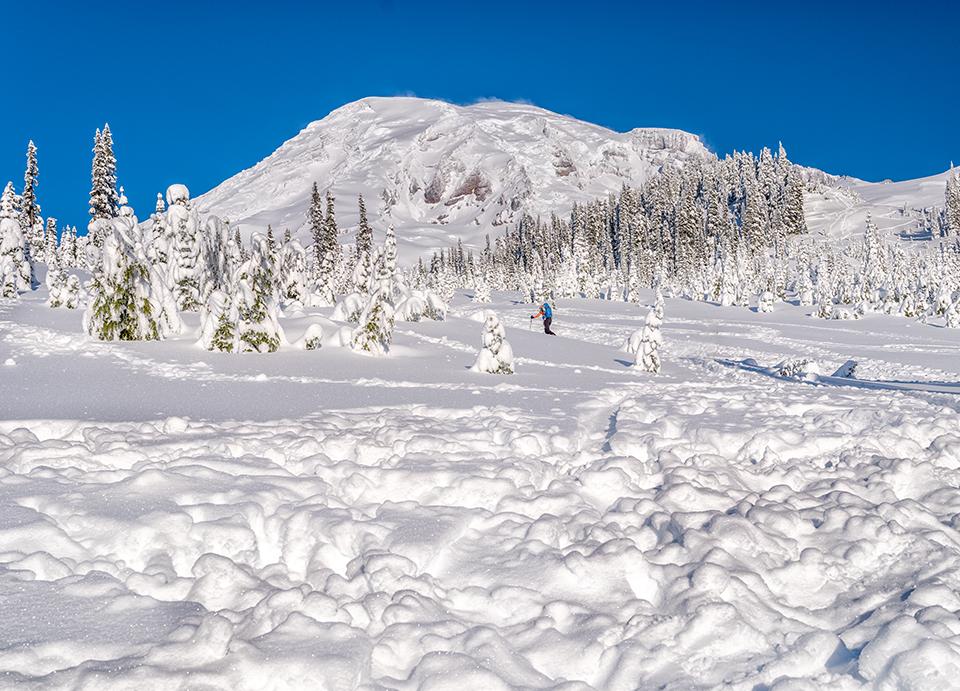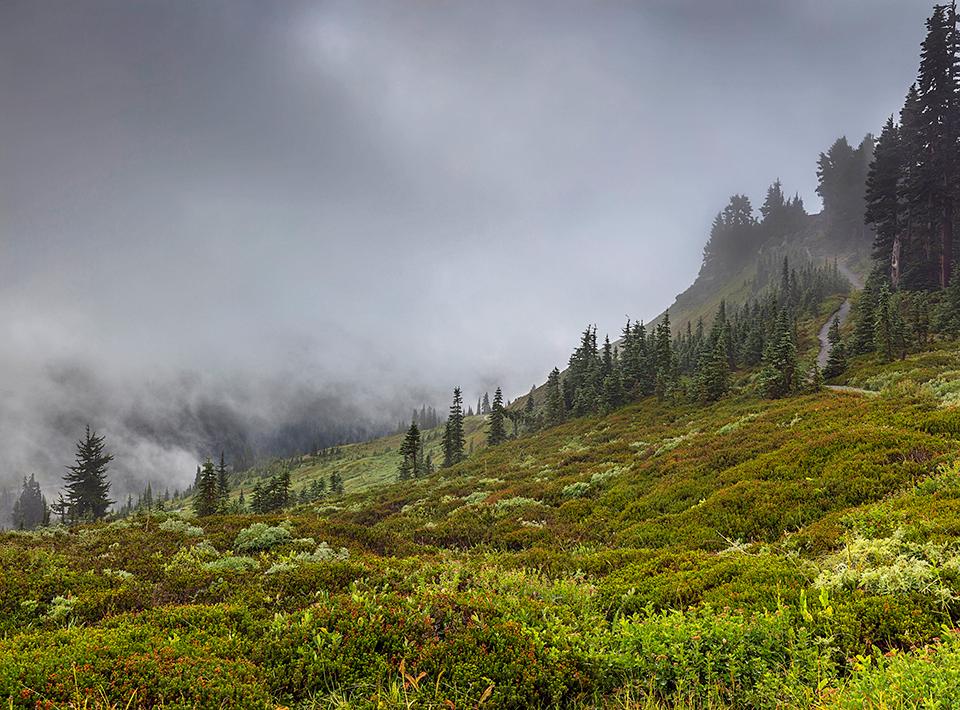
Summer and winter landscape changes at Biscuit Basin, Yellowstone National Park / Rebecca Latson
Everybody has a favorite national park, even if they say they like them all equally. C’mon, be honest. There is at least one park unit within the National Park System that resonates with you more than others. There’s one, maybe two or even three, park units you may find yourself returning to, given the time (and money). Why? Is it for a particular view area? A particular hike? When you return to that park, do you revisit those same view areas? Trek that same trail? You should.
Oh sure, it’s good to hike new trails and view new vistas. When I return to a familiar national park, I try to hike at least one new trail to allow myself exploration of a hitherto undiscovered landscape. In addition to that new hike, though, it’s also a great feeling revisiting a spot to which I’ve traveled before, because I’m familiar with the layout and thus know how I wish to compose my photo of a great scene associated with a wonderful memory. Plus, this same favorite spot may look quite a bit different depending upon the season, time of day, or weather conditions. I want to see and photograph the results of those changing conditions.
Many parks exhibit marked contrasts during different seasons, from summer green to autumn orange to winter’s snowy monochromatic palette. Due to these variations, your photo of a spot you visited one month, or even one year in the past may not look exactly the same. This happens to me all the time when I return to a beloved national park. I even wrote an article for the Traveler about this very subject back in 2014. That was almost nine years ago, so I thought I’d return to this topic with fresh photos and one or two tips.
The two-shot image gracing the top of this article was photographed at Biscuit Basin in Yellowstone National Park. The one to the left was taken during a bright, hot summer day and the one on the right was taken during a subfreezing winter visit. Not only does the background vegetation look different, and the one shot is peopled while the other is not, but even the color of algae thriving beneath that leading line of shallow water is different because the water temperature has changed.
The images below of “The Mountain” as seen in the Paradise area of Mount Rainier National Park were each captured at or very near the same spot, at or between sunrise and mid-late morning, during different seasons of the year.

A summer sunrise over "The Mountain," Mount Rainier National Park / Rebecca Latson

Autumn colors of sunrise at Paradise, Mount Rainier National Park / Rebecca Latson

The monochrome-ish colors of winter at Paradise, Mount Rainier National Park / Rebecca Latson
The photos of Ruby Beach at Olympic National Park were shot along the same trail and almost the same spot during different seasons and times of day.

A summer morning trail view of Ruby Beach, Olympic National Park / Rebecca Latson

A summer sunset afterglow over Ruby Beach, Olympic National Park / Rebecca Latson

A view of Ruby Beach on a winter afternoon, Olympic National Park / Rebecca Latson
The landscape of Mount Rainier’s Alta Vista view area up at Paradise shows a definite contrast between the bright, clear light of a blue-and-white winter afternoon and the rain-wet moody greens of a late-summer morning.

The bright winter blue and white of Alta Vista, Mount Rainier National Park / Rebecca Latson

The beauty of a rainy summer day at Alta Vista, Mount Rainier National Park / Rebecca Latson
I do admit, there are some scenes in which the environment looks similar, regardless of weather, time, or season, but a closer inspection of the landscape reveals variations. For instance, the winter and autumn images of Upper Geyser Basin’s Crested Pool don’t look too different from each other. Both have a snowy, murky, overcast appearance. Look a little closer at these shots, though. What’s different? Do you see thicker snow cover in the winter shot compared to the autumn photo? Notice the ice-encrusted hoof prints in the winter composition versus the non-ice-encrusted prints in the autumn composition? Even the number and shape of those prints around the hot spring have changed.

Crested Pool in the winter, Upper Geyser Basin, Yellowstone National Park / Rebecca Latson

Crested Pool on a cold autumn day, Upper Geyser Basin, Yellowstone National Park / Rebecca Latson
Looking at each image in this article, you’ve observed the variations in light, right? This is something you should consider when capturing the same spot under differing conditions. For you SLR users, low-light affairs such as blue hour, sunrise, sunset, or overcast days mean you’ll probably need to use a higher ISO and wider aperture. Sunny, bright venues require use of a faster shutter speed, smaller aperture, and a much lower ISO.
You can up your photographic game and learn a lot about your camera by experimenting with the various settings (yes, that means taking your camera off Auto). Point-and-shoot and smartphone users may apply in-camera programmed modes (daytime, shadows, rainy days, nighttime) which helps control exposure to a certain extent. Master those settings and you’ll feel a greater sense of expertise and accomplishment regarding your photography. Just remember to practice those controls before you head out to your national park destination. I confess to having done the opposite during a trip or two, and I’ve wasted precious minutes of optimal landscape lighting (or wildlife sighting) while fiddling around with a new setting.
In addition to managing exposure via your camera controls, lens filters help immensely with managing light, color saturation, and texture enhancements. There are two filters every photographer should have in their camera bag: a circular polarizer and a graduated neutral density filter. Circular polarizing filters (CPLs or just “polarizers”) act like your sunglasses, reducing or even eliminating glare and reflections in addition to saturating colors and producing dramatic skies.
Graduated neutral density (grad ND) filters are half shaded and half clear. The shaded portion augments cloud textures for dramatic skies and prevents “blowing out” (overexposing) the bright horizon while you expose for the darker areas within your composition.
Smartphone users can download editing apps simulating these two filters’ results. Point-and-shoot users can purchase polarizers and grad NDs small enough to fit over your compact camera’s lens. Nowadays, there are so many great choices to help you capture great images.
Once you are properly armed with camera control know-how and two important lens filters, I encourage you to brave the vagaries of the environment and drive or hike to that favored view of a park you are revisiting. Go in the early morning, midday, and late evening. Observe those alterations in light and character and capture those changes with your camera. See for yourself (and show your viewing audience) just how different the same spot can look during different times, seasons, and weather conditions.

The bright summer colors of Crested Pool, Upper Geyser Basin, Yellowstone National Park / Rebecca Latson




 Support Essential Coverage of Essential Places
Support Essential Coverage of Essential Places







Comments
Great photos & story! Keep them coming!
I was just at Ruby Beach last summer.